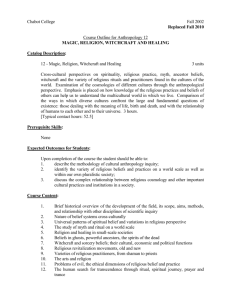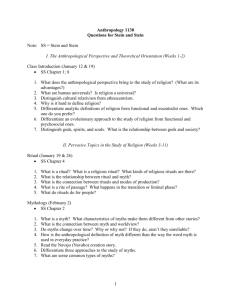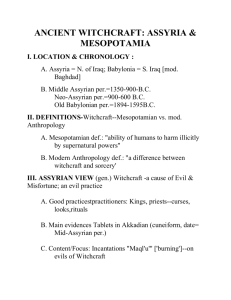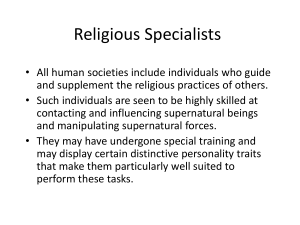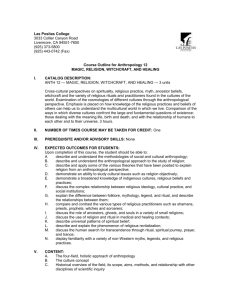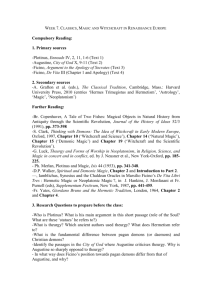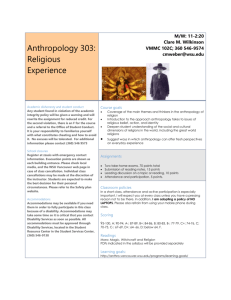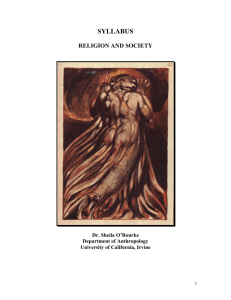Syllabus
advertisement
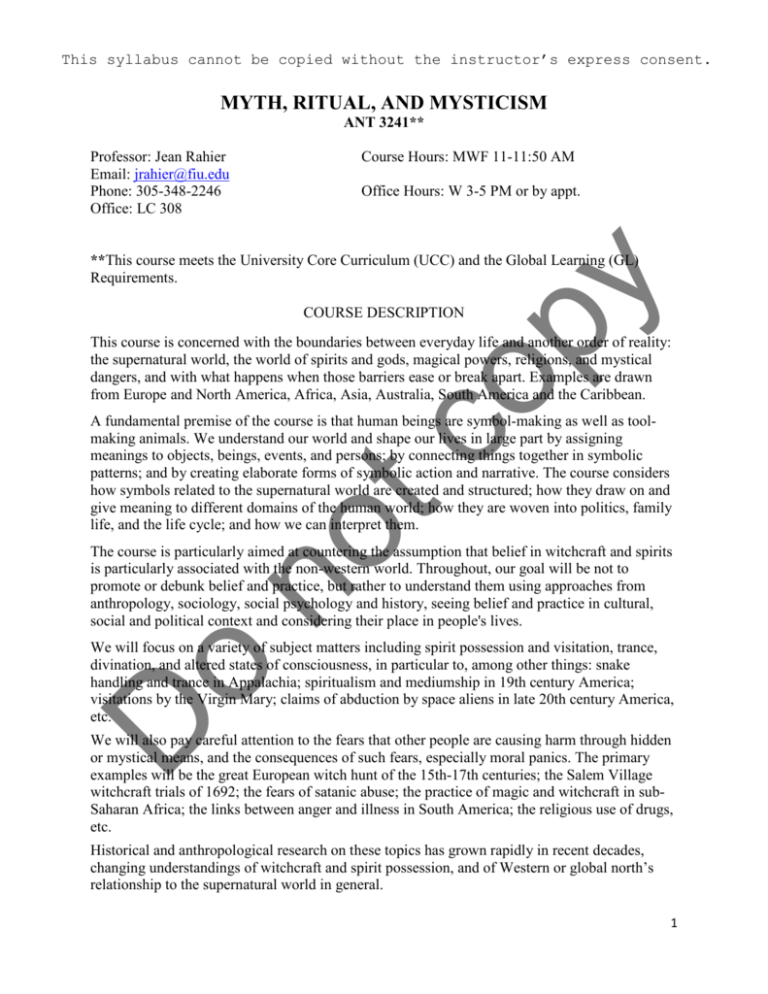
This syllabus cannot be copied without the instructor’s express consent. MYTH, RITUAL, AND MYSTICISM ANT 3241** Professor: Jean Rahier Email: jrahier@fiu.edu Phone: 305-348-2246 Office: LC 308 Course Hours: MWF 11-11:50 AM Office Hours: W 3-5 PM or by appt. op COURSE DESCRIPTION y **This course meets the University Core Curriculum (UCC) and the Global Learning (GL) Requirements. This course is concerned with the boundaries between everyday life and another order of reality: the supernatural world, the world of spirits and gods, magical powers, religions, and mystical dangers, and with what happens when those barriers ease or break apart. Examples are drawn from Europe and North America, Africa, Asia, Australia, South America and the Caribbean. no tc A fundamental premise of the course is that human beings are symbol-making as well as toolmaking animals. We understand our world and shape our lives in large part by assigning meanings to objects, beings, events, and persons; by connecting things together in symbolic patterns; and by creating elaborate forms of symbolic action and narrative. The course considers how symbols related to the supernatural world are created and structured; how they draw on and give meaning to different domains of the human world; how they are woven into politics, family life, and the life cycle; and how we can interpret them. The course is particularly aimed at countering the assumption that belief in witchcraft and spirits is particularly associated with the non-western world. Throughout, our goal will be not to promote or debunk belief and practice, but rather to understand them using approaches from anthropology, sociology, social psychology and history, seeing belief and practice in cultural, social and political context and considering their place in people's lives. D o We will focus on a variety of subject matters including spirit possession and visitation, trance, divination, and altered states of consciousness, in particular to, among other things: snake handling and trance in Appalachia; spiritualism and mediumship in 19th century America; visitations by the Virgin Mary; claims of abduction by space aliens in late 20th century America, etc. We will also pay careful attention to the fears that other people are causing harm through hidden or mystical means, and the consequences of such fears, especially moral panics. The primary examples will be the great European witch hunt of the 15th-17th centuries; the Salem Village witchcraft trials of 1692; the fears of satanic abuse; the practice of magic and witchcraft in subSaharan Africa; the links between anger and illness in South America; the religious use of drugs, etc. Historical and anthropological research on these topics has grown rapidly in recent decades, changing understandings of witchcraft and spirit possession, and of Western or global north’s relationship to the supernatural world in general. 1 In this course, we will be concerned not so much with coming to absolute conclusions as with learning how to analyze belief and practice; appreciating the complexity and ambiguity of the historical and anthropological record; and with weighing alternative interpretations. y There is no final exam. Students will present a quiz (multiple choice and short answer questions) at the end of each chapter, and will write two essays and a small research assignment over the course of the semester. We will see a number of films as they will provide a major source of ethnographic information. Each film’s content will be directly related to a specific chapter. The quizzes will include questions (multiple choice and/or short answer) about the content of every chapter (and their related required readings) and the content of all the films. • • • • • • D o • • • tc • Understand the culturally informed and quite diverse imaginations about the supernatural world and supernatural forces in different societal contexts, from the post-industrial global north (Western Europe and North America), to the BRIC countries, and so-called traditional societies in Africa, the Americas, Asia, and Australia. Better understand the linkages and non-hierarchically determining differences among distinct human beliefs, from more or less complex religious systems, about magic and witchcraft, superstition, sorcery and mysticism. Understand the links that exist, differently in different societies, between spirituality, religious beliefs, and conviction of the existence of supernatural forces on one side and other aspects of societies including health care. Be able to contextualize their own religious beliefs, spirituality, and/or lack thereof thanks to a better understanding of beliefs they are unfamiliar with. Be a better world citizen by understanding the existence of different ways of being human, of being spiritual and religious or atheist. Describe the nature of anthropological fieldwork and contrast its methodology with that of other disciplines. Explain how terms such as “culture” and “religion” are defined in anthropology. Explain and differentiate between different theoretical approaches to the study of religion. Explain the concept of ritual and categorize different types of ritual. Compare and contrast different types of religious specialists. Explain altered states of consciousness and describe the role they play in religious experiences. Differentiate between various types of supernatural entities including gods, spirits, souls, ghosts, and ancestors. no • op STUDENT LEARNING OUTCOMES By the end of this course students will be able to: • GL STUDENT LEARNING OUTCOMES By the end of this course, students will be able to: • Demonstrate an understanding of the historical and contemporary inter-relatedness of key local, regional and global religious and spiritual issues and events, including beliefs in magic, witchcraft, sorcery and various kinds of superstitions. (GLOBAL AWARENESS) 2 • Demonstrate the ability to compose an analysis of various perspectives associated with different culturally-based conceptualizations of the supernatural world and their attendant practices and rituals, which can also be linked to different geographic locations on the global stage. (GLOBAL PERSPECTIVE) • Willingly better engage in a number of problem solving activities in a variety of sociocultural contexts around the globe. (GLOBAL ENGAGEMENT) These three GL student learning outcomes will be assessed as follows: Global Learning (GL) Assessments y Students are required to make a short final presentation to the class based on their independent research project. COURSE REQUIREMENTS Students are required to attend class and participate in discussions. There are eleven quizzes based on assigned readings and films. These quizzes will be a combination of multiple choice and short answer questions and will cover both the contents of the required readings and the films, o • no tc • Every enrolled student will have to write two relatively short essays during the semester, one during each half of the semester. These essays will be of 5-8 pages and focus on one specific theme/question, which will be revealed to students two weeks prior to the due date. These essays will ask students to demonstrate mastery of the material covered as well as an ability to apply the acquired knowledge to an improved understanding of the global world. As such, each one of these essays’ focus will make direct reference to a relevant recent news event. (GLOBAL AWARENESS) Students are required to write a term paper (10-12 pages) that will be based on both library research and brief fieldwork conducted in at least one South Florida religious or spiritual community to which the student doesn’t belong. The paper will be focused on one or two closely related and comparable local/global religious performance(s) or ritual(s). One and only one of these two religious/spiritual communities may be well known by the student author of the paper. This GL requirement asks students to demonstrate comprehension of the existence of various perspectives associated with different religious/spiritual subjectivities and diverse cultural backgrounds. It also asks students to demonstrate their willingness to engage— thanks to what they have learned in this class—in a number of problem solving activities in a variety of sociocultural contexts around the globe. (GLOBAL PERSPECTIVE and GLOBAL ENGAGEMENT) op • D • • FINAL GRADE CALCULATION Class Participation and Facilitation: 11 Quizzes (60 POINTS EACH) 2 essays (5-8 pages) (50 POINTS EACH) Final Paper (10-12 pages) and Presentation TOTAL 100 pts 660 pts 100 pts 140 pts 1,000pts 3 1000-940 A 930-900 A- 890-870 860-840 830-800 B+ B B- 790-770 760-740 730-700 C+ C C- 690-670 D+ 660-640 D 630-600 D- < 600 F EXTRA CREDIT op GROUND RULES y The total number of points that you can earn in this course is 1,000. However, throughout the semester, you may have opportunities (probably only one) to earn extra credit through attending event(s) relevant to the course and writing a reaction paper or report. More information about extra credit opportunities will be placed in due time on the Moodle website associated with this course. COURSE MATERIALS D o no tc 1) Turn your cell phones OFF. If you have an emergency and have to use it, leave the room so that I do not have to request that you do so. 2) Use laptops ONLY for course related activity (ie: taking notes). No e-mail, text, or other messaging allowed. 3) Arrive to class ON TIME. Persistent lateness will result in a lower grade. 4) Papers are to be submitted electronically on the Moodle website (turnitin.com upload) associated with this course. NO late papers will be accepted for full credit without a medical excuse. Each day late will result in the loss of 10% of the total possible points. 5) Plagiarism is a serious offense. If you use the work of other authors without giving them credit, you will receive a ‘0’ for the assignment and you will be reported to Academic Affairs. To avoid plagiarism, all assignments will have to be uploaded on a turnitin.com site associated with this course (see the Moodle site associated with this course). 6) Papers must include a title, your name, the course name and number, and page numbers. 7) All email correspondence must begin with a salutation (Professor ________:, Dear Dr. ________, Hi Professor _______, etc.) and end with your name. I will not read your email if you fail to include this. 8) In this course, we will be discussing topics some might consider sensitive, provocative, or taboo such as race, sexuality, and religious beliefs. It is imperative that you express your opinions in a respectful manner. Readings from this course consist of one text book and a series of articles. There are also several required films. All readings (at the exception of the text book indicated below) and films will be available on the course’s Moodle website. Required readings for the course are located below in the weekly section for which they are assigned. Required readings must be done PRIOR each day of class. This will allow for informed in-class participation. Book available at the FIU bookstore: Stein, Rebecca L. and Philip L. Stein 2011 The Anthropology of Religion, Magic, and Witchcraft. Third Edition. Pearson. eText 4 ISBN-10 0-205-71809-4 ISBN-13 978-0-205-71809-2 Print ISBN-10 0-205-71811-6 ISBN-13 978-0-205-71811-5 COURSE SCHEDULE D o no tc op y WEEKS ONE & TWO -Presentation and explanation of the course's objectives, student learning outcomes, assignments, and other details -Introduction to the discipline of anthropology and the study of religions •Watch the video "Anthropologists at Work" -Chapter I: The Anthropological Study of Religion THE ANTHROPOLOGICAL PERSPECTIVE The Holistic Approach The Study of Human Societies The Fore of New Guinea: An Ethnographic Example Two Ways of Viewing Culture Cultural Relativism Postmodernism Universal Human Rights The Concept of Culture Viewing the World THE STUDY OF RELIGION Attempts at Defining Religion The Domain of Religion Theoretical Approaches to the Study of Religion The Evolutionary Approach The Marxist Approach The Functional Approach The Interpretive Approach The Psychosocial Approach The Biological Basis of Religious Behavior Belief in Spirit Beings The Evolution of Religion -Required Readings: •Pages 1-28 of The Anthropology of Religion, Magic, and Witchcraft. •“Why We Became Religious and The Evolution of the Spirit World.” In Our Kind, Marvin Harris 1989: pages 16-19. -Watch the short Films “The Discipline of Anthropology” AND “Doing Anthropology.” -Quiz # 1 WEEKS THREE & FOUR -Discussion of Global Learning common reading “The Case for Contamination” 5 y tc op -Chapter II Mythology THE NATURE OF MYTHS Worldview Stories of the Supernatural Myths The Nature of Oral Texts Genesis UNDERSTANDING MYTHS Approaches to Analysis of Myths Searching for Myth Origins in the Nineteenth Century Fieldwork and Functional Analysis Structural Analysis Psychoanalytic Symbols in Myth Common Themes in Myths Origin Myths Apocalyptic Myths Trickster Myths Hero Myths CONCLUSION no -Required Readings: •GL reading Appiah, Kwame Anthony 2006 “The Case for Contamination.” The New York Times. Thenewyorktimes.com: 1-7. •Pages 29-55 of The Anthropology of Religion, Magic, and Witchcraft. •Douglas, Mary 1979 “Taboo.” In Richard Cavendish, ed. Man, Myth, and Magic. Pages 72-76. •Daugherty, Mary Lee 1976 “Serpent-Handling as Sacrament.” Theology Today 33:3. October. Pages 77-82. -Watch Film “Off the Verandah” -Quiz # 2 D o WEEK FIVE -Chapter III Religious Symbols WHAT IS A SYMBOL? Religious Symbols The Swastika The Pentagram Christian Symbols SACRED ART The Sarcophagus of Lord Pakal The Meaning of Color Yoruba Color Terminology SACRED SPACE AND SACRED TIME The Meaning of Time The Mayan View of Time Rituals and Calendars in Modern World Religions 6 y Sacred Time and Space in Australia Totemism and the Dream Time in Australia Murngin Totemism THE SYMBOLISM OF MUSIC AND DANCE The Symbolism of Music Music in Ritual The Symbolism of Dance CONCLUSION SUMMARY BOX 3.1 RELIGIOUS TOYS AND GAMES BOX 3.2 THE END OF TIME op -Required Readings: •Pages 56-76 of The Anthropology of Religion, Magic, and Witchcraft. •Wolf, Eric 1958 “The Virgin of Guadalupe: A Mexican National Symbol.” Journal of American Folklore. 71:279. Pages 67-71. -Quiz # 3 D o no tc WEEK SIX -Chapter IV Ritual THE BASICS OF RITUAL PERFORMANCE Prescriptive and Situational Rituals Periodic and Occasional Rituals A Classification of Rituals A SURVEY OF RITUALS Technological Rituals Hunting and Gathering Rites of Intensification Protective Rituals Social Rites of Intensification Offerings and Sacrifices Human Sacrifice Therapy Rituals and Healing The Navaho Anti-Therapy Rituals Salvation Rituals Revitalization Rituals Rites of Passage The Structure of a Rite of Passage Coming-of-Age Rituals Transition and Liminality Apache Rite of Passage U.S. Secular Rites of Passage Alterations of the Human Body Tattooing and Other Permanent Alterations Genital Cutting Pilgrimages 7 The Huichol Pilgrimage RELIGIOUS OBLIGATIONS Tabu Mana and Tabu in Polynesia Jewish Food Laws CONCLUSION SUMMARY BOX 4.1 THE HAJJ BOX 4.2 MENSTRUAL TABUS op y -Required Readings: •Pages 77-102 of The Anthropology of Religion, Magic, and Witchcraft. •Turner, Victor 1964 “Betwixt and Between: The Liminal Period in Rites de Passage.” The Proceedings of the New American Ethnological Society…: 87-96. •Miner, Horace 1956 “Body Ritual Among the Nacirema.” American Anthropologist 58: 135138. -Watch Film: “Guardians of the Flutes” -Quiz 4 D o no tc WEEK SEVEN Chapter V Altered State of Consciousness THE NATURE OF ALTERED STATES OF CONSCIOUSNESS Entering an Altered State of Consciousness Fasting Sacred Pain The Biological Basis of Altered States of Consciousness Drug Induced Altered States The Importance of a Ritual Setting The Role of Altered States in Religious Practice ETHNOGRAPHIC EXAMPLES OF ALTERED STATES OF CONSCIOUSNESS The Holiness Churches San Healing Rituals The Sun Dance of the Cheyenne Religious Use of Drugs in South America Rastafarians CONCLUSION SUMMARY BOX 5.1 ALTERED STATES IN UPPER PALEOLITHIC ART BOX 5.2 THE NATIVE AMERICAN CHURCH -Required Readings: •Pages 103-118 of The Anthropology of Religion, Magic, and Witchcraft. •Lewis, I.M. 2003 “Trance, Possession, Shamanism, and Sex.” Anthropology of Consciousness, 14:1. Pages 188-195. •Kiyaani, Mike and Thomas Csordas 1997 “On the Peyote Road.” Natural History. March: 207-209. 8 •Furst, Peter and Michael Coe 1977 “Ritual Enemas.” Natural History. March: 210-213. -Watch Film: “The Peyote Road” -Quiz 5 no tc op y WEEK EIGHT Chapter VI Religious Specialists SHAMANS Defining Shamanism Becoming a Shaman The Shamanic Role and Rituals Siberian Shamanism Yakut Shamanism Shamanism among the Akimel O’odham Korean Shamanism Pentecostal Healers as Shamans Neoshamanism PRIESTS Zuni Priests Okinawan Priestesses Eastern Orthodox Priests OTHER SPECIALISTS Healers and Diviners Prophets CONCLUSION SUMMARY BOX 6.1 CLOWN DOCTORS AS SHAMANS BOX 6.2 AFRICAN HEALERS MEET WESTERN MEDICINE D o -Required Readings: •Pages 119-135 of The Anthropology of Religion, Magic, and Witchcraft. •Turner, Victor 1972 “Religious Specialists.” International Encyclopedia of the Social Sciences. David Sills, Ed. Vol. 13: 142-149. •Fobes Brown, Michael 1989 “Dark Side of the Shaman.” Natural History. November: 158161. -Quiz 6 WEEK NINE Chapter VII Magic and Divination THE WORLD OF MAGIC Magic and Religion Magic and Science Rules of Magic Homeopathic Magic Contagious Magic The Function of Magic Why Magic Works 9 y tc op MAGIC IN SOCIETY Magic in the Trobriand Islands Learning Magic Magical Ritual Magic among the Azande Sorcery among the Fore Wiccan Magic DIVINATION Forms of Divination Divination Techniques Inspirational Forms Ordeals Fore Divination Oracles of the Azande Divination in Ancient Greece: The Oracle at Delphi Astrology CONCLUSION SUMMARY BOX 7.1 TROBRIAND ISLAND MAGIC BOX 7.2 I-CHING: THE BOOK OF CHANGES no -Required Readings: •Pages 136-160 of The Anthropology of Religion, Magic, and Witchcraft. •Malinowski, Bronislaw 1955 “Rational Mastery by Man of His Surroundings.” In Magic, Science and Religion. New York: Doubleday: 314-319. •Gmelch, George 1971 “Baseball Magic.” Transaction. 8:8. 320-327. -Quiz 7 D o WEEK TEN Chapter VIII Souls, Ghosts, and Death SOULS AND ANCESTORS Variation in the Concept of the Soul Souls, Death and the Afterlife Examples of Concepts of the Soul Yup’ik Souls Yanomamö Spirits and Souls Hmong Souls The Soul in Roman Catholicism The Soul in Hinduism and Buddhism Ancestors Yoruba Ancestors Beng Ancestors and Reincarnation Tana Toraja Ancestors Ancestors and the Departed in Japan BODIES AND SOULS Ghosts 10 y no tc op Dani Ghosts Bunyoro Ghosts Japanese Ghosts The Living Dead: Vampires and Zombies Vampires The Viking Draugr Haitian Zombies Zombies in Modern American Culture DEATH RITUALS Funeral Rituals Disposal of the Body Burial The African Burial Ground Secondary Burials Cremation Mummification Exposure U.S. Death Rituals in the Nineteenth Century U.S. Funeral Rituals Today DAYS OF DEATH Halloween Day of the Dead (Dia de los Muertos) CONCLUSION SUMMARY BOX 8.1 HOW DO YOU GET TO HEAVEN? BOX 8.2 DETERMINING DEATH BOX 8.3 ROADSIDE MEMORIALS D o -Required Readings: •Pages 161-188 of The Anthropology of Religion, Magic, and Witchcraft. •Barber, Paul 1988 “The Real Vampire.” From Vampires, Burial, and Death by Paul Barber. Pages 332-337. •Brandes, Stanley 2001 “The Cremated Catholic: The End of a Deceased Guatemalan.” Body and Society. 7:2-3. Pages 349-355. -Watch Film: -Quiz 8 WEEK ELEVEN Chapter IX Gods and Spirits SPIRITS The Dani View of the Supernatural Guardian Spirits and the Native American Vision Quest Jinn Spirit Possession in the Sudan Christian Angels and Demons GODS 11 op y Types of Gods Gods and Society The Gods of the Yoruba Gods of the Ifugao Goddesses Ishtar (Ancient Near East) Isis (Ancient Egypt) Kali (Hinduism) Mary (Roman Catholic) Monotheism: Conceptions of God in Judaism, Christianity, and Islam Judaism Christianity Islam Atheism CONCLUSION SUMMARY BOX 9.1 CHRISTIAN DEMONIC EXORCISM IN THE UNITED STATES BOX 9.2 GAMES AND GODS tc -Required Readings: •Pages 189-212 of The Anthropology of Religion, Magic, and Witchcraft. -Watch Film: -Quiz 9 D o no WEEK TWELVE Chapter X Witchcraft THE CONCEPT OF WITCHCRAFT IN SMALL-SCALE SOCIETIES Witchcraft among the Azande The Zande Belief in Witchcraft A Case of Witchcraft An Analysis of Zande Witchcraft Beliefs Witchcraft among the Navaho Witchcraft Reflects Human Culture Sorcery, Witchcraft, and AIDS EURO-AMERICAN WITCHCRAFT BELIEFS The Connection with Pagan Religions The Witchcraze in Europe The Witchcraze in England and the United States Functions of Euro-American Witchcraft Beliefs Witches as Women Modern-Day Witch Hunts BOX 10.1 THE EVIL EYE BOX 10.2 SATANISM -Required Readings: •Pages 213-229 of The Anthropology of Religion, Magic, and Witchcraft. 12 •Evans-Pritchard, E.E. 2010 “Consulting the Poison Oracle Among the Azande” In Magic, Witchacraft and Religion. McGraw Hill: 308-313. •Brain, James 1989 “An Anthropological Perspective on the Witchcraze.” In The Politics of Gender in Early Modern Europe, J. Brink, A. Coudert, and M. Horowitz, eds. Sixteenth Century Journal Publishers: 283-289. -Watch Film: “Strange Beliefs” -Quiz 10 D o no tc op y WEEK THIRTEEN & FORTEEN Chapter XI The Search for new Meaning ADAPTATION AND CHANGE Mechanisms of Culture Change Acculturation Syncretism Haitian Vodou History of Vodou Vodou Beliefs Santeria REVITALIZATION MOVEMENTS The Origins of Revitalization Movements Types of Revitalization Movements Cargo Cults The Ghost Dance of 1890 The Church of Jesus Christ of Latter-Day Saints (Mormonism) NEO-PAGANISM AND REVIVAL The Wiccan Movement Wiccan Beliefs and Rituals The Growing Popularity—and Persecution—of Wicca NEW RELIGIOUS MOVEMENTS The “Cult” Question Characteristics of High Demand Religious Groups Mind Control? Genuinely Dangerous Religious Groups Examples of New Religious Movements Branch Davidians (Students of the Seven Seals) Unification Church (Moonies) UFO Religions Heaven’s Gate Raelians FUNDAMENTALISM Characteristics of Fundamentalist Groups Mormon Fundamentalism Islamic Fundamentalism CONCLUSION SUMMARY BOX 11.1 THE JOHN FRUM CULT 13 BOX 11.2 RELIGIOUS VIOLENCE AND TERRORISM y -Required Readings: •Pages 230-258 of The Anthropology of Religion, Magic, and Witchcraft. •McCarthy Brown, Karen 2005 “Vodou.” In Encyclopedia of Religion, Second Edition, Thomson Gale Pub.: 338-344. •Wallace, Anthony 1970 “Revitalization Movements.” In Anthony Wallace’s Culture and Personality, N.Y.: Randhom House: 360-365. •Barkun, Michael 1993 “Reflections After Waco: Millenialists and the State.” Christian Century, June: 177-183. •Juergensmeyer, Mark 2002 “Religious Terror and Global War.” In Understanding September 11, C. Calhoun, ed., NY: The Free Press: 435-443. D o no tc op -Students’ Presentations of Term Papers on the Moodle website associated with this course -Watch Film: “Orientalism” -Quiz 11 -Term papers due on Tuesday of last week of class at midnight on the Moodle website associated with this course. 14
